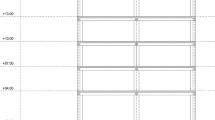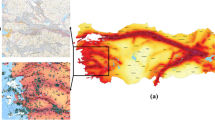Abstract
The seismic stability of the facade brick-masonry walls of the machinery building of the Beauharnois powerhouse near Montreal, Quebec, Canada were investigated numerically by use of non-linear models and applying experimental methods on site and on the IZIIS’ seismic shake-table. The dynamic properties of the machinery building were obtained by ambient vibration measurements. Based on these results, a model of a representative part of the building, consisting of steel frames and brick masonry wall, was designed and constructed to the reduced scale at the IZIIS’ Dynamic Testing Laboratory and then tested on the two-component shake-table. The geometry of the original structure was completely scaled to 1/3, consisting of many realistically simulated details such us: brick layers, steel columns, openings, window frames, steel connectors between brick layers, number of layers, brick dimensions, etc. The material used for the model was: original steel for the frame structure and bricks of reduced mechanical properties for the masonry wall, close to the similitude requirements according to the Backingham’s theorem, valuable for adequate artificial—mass simulation model as well as true replica simulation model. More than 50 seismic tests were performed considering the design earthquake Nahanni NWT, H1, with a time scaling factor of 31/2, and acceleration scaling factor 1, according to the model design rules. The intensity of the applied input earthquake excitation was from 0.05 to 1.2 g. The design peak acceleration of Nahanni earthquake was 0.2 g. The cracks development was stated at 0.7 g input acceleration. These were concentrated around the openings. No collapse happened even under the strongest earthquake input. The numerical part of this paper deals with formulation/application of the critical plane approach to seismic analysis of masonry structures. Starting with the constituents, i.e. mortar and bricks, the macroscopic strength properties of masonry were established based on numerical homogenization. Generally, based on all the performed experimental tests, considering some simplifications and assumptions in the constructing details, as well as in the design of the model, the global conclusion is that the existing wall is very well incorporated in the steel structure of the powerhouse. The complementary stiffness of the steel frame and the brick masonry wall produces interactive deformation of the system. Only local cracking and relative displacement between the wall and the steel frames could be expected in the case of a strong earthquake.
Similar content being viewed by others
References
Atkinson G (2006) Earthquake time histories for Montreal, Quebec, 2% in 50 year exceedence probability, July 5
Fridman D (2004) Analysis of steel-structure/masonry-walls interaction in historic buildings. Proceedings of the 4th international seminar on structural analysis of historical constructions, 10–13 November 2004, Padova, Italy, pp 103–110
Gocevski V (2007) Centrale de Beauharnois—analyse et confortement sismique de l’enveloppe de la centrale. Rapport D’avant-projet, Hydro-Québec Unité Structure, RPOOW 12242 001—STR
Jurukovski D, Taskov LJ, Petkovski M, Gavrilovic P (1989) Basic and applied research study for seismic modeling of mixed reinforced concrete masonry buildings—shake-table tests of reduced scale model—original. IZIIS report 89/66, July 1989
Pietruszczak S, Niu X (1992) A mathematical description of macroscopic behavior of brick masonry. Int J Solids Struct 29(5): 531–546
Pietruszczak S, Ushaksaraei R (2003) Description of inelastic behavior of structural masonry. Int J Solids Struct 40(15): 4003–4020
Samarasinghe W, Hendry AW (1982) Strength of Brickwork under Biaxial Tensile and compressive stress. Proc Br Ceram Soc 30: 129–139
Taskov L, Krstevska L, Garevski M (2006) Experimental investigation of seismic stability on masonry walls at Beauharnois powerhouse. Report—Institute of Earthquake Engineering and Engineering Seismology. IZIIS, Skopje
Ushaksaraei R, Pietruszczak S (2002) Failure criterion for structural masonry based on critical plane approach. J Eng Mech ASCE 128(7): 769–778
Author information
Authors and Affiliations
Corresponding author
Rights and permissions
About this article
Cite this article
Krstevska, L., Tashkov, L., Gocevski, V. et al. Experimental and analytical investigation of seismic stability of masonry walls at Beauharnois powerhouse. Bull Earthquake Eng 8, 421–450 (2010). https://doi.org/10.1007/s10518-009-9142-5
Received:
Accepted:
Published:
Issue Date:
DOI: https://doi.org/10.1007/s10518-009-9142-5




